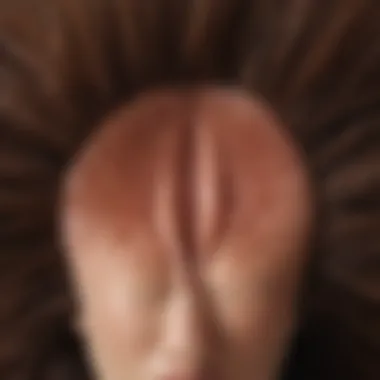Understanding and Addressing Hair Fallout Strategies


Intro
Dealing with hair fallout can feel like an uphill battle. For many, it's more than just an aesthetic concern; it's a source of anxiety that can impact self-esteem and overall well-being. This article aims to unpack the intricacies surrounding this common issue, diving into the anatomy of hair loss while also shedding light on effective strategies for addressing it. The journey involves not only understanding the biological and genetic factors that contribute to hair fallout but also examining how lifestyle choices can play a significant role.
Hair shedding can be influenced by a variety of elements, including stress, diet, and environmental factors. Thus, a comprehensive approach is essential. Those who wish to maintain lush, vibrant locks will find various insights and solutions throughout this narrative.
We will look at preventive measures, treatment options, and holistic approaches tailored to people across different demographics. Understanding hair fallout is no longer just about finding products; it's about creating a lifestyle that supports hair health.
As we move forward, let’s start by exploring some fashionable choices that intertwine with our hair journey.
Fashion Trends and Must-Have Pieces
While hair fallout is often seen as a personal concern, it intersects with broader fashion trends, inviting us to creatively express ourselves and find solutions through style.
Runway Reports
Recent runway shows have introduced styles that embrace individuality. Models flaunted looks that included wigs and hairpieces designed not just for aesthetics but also to showcase resilience in the face of hair loss. Designers are increasingly acknowledging the urgency for inclusive fashion that caters to varying needs, making alternatives like hair extensions more popular. This shifting mindset encourages a bolder approach to self-expression, regardless of hair situation.
Street Style Features
On city streets worldwide, we're witnessing a revival of headwear, from chic turbans to elegant hats. People are often turning to these accessories not just as a fashion statement but as a way to manage hair concerns while still looking stylish. The styles are as diverse as the wearers—think bohemian flair with colorful wraps or self-assured minimalism with sleek, monochrome designs. The key takeaway here is flexibility; when facing challenges like hair fallout, embracing your own unique style can be a great confidence booster.
Seasonal Must-Haves
As seasons change, so do the ways we approach hair health within our styling choices. Colder months often necessitate protective hairstyles or the incorporation of nourishing hair oils to combat the drying effects of winter air. Come summer, embracing lighter styles and breathable fabrics can result in better scalp health. Stay attuned to the seasons and consider how your clothing choices can align with a holistic approach to hair care.
"Embracing change in fashion is a way to manage the changes we encounter in life—it’s both a strategy and a statement."
Beauty Tips and Tricks
A holistic approach to combat hair fallout incorporates beauty essentials alongside strategic practices.
Skincare Routines
A healthy scalp translates to healthy hair. Incorporate gentle exfoliation into your skincare regime to remove excess buildup that could hinder hair growth. Products rich in vitamins and antioxidants are beneficial.
Makeup Tutorials
Though makeup might not directly affect hair health, presenting yourself confidently through makeup can change how you perceive your overall look. Learning which colors and techniques highlight your best features can distract from any hair concerns.
Haircare Tips
Consistent care is vital. Invest time in understanding your hair type and choose shampoos, conditioners, and serums that support your particular needs. Techniques such as scalp massages can stimulate circulation and promote hair growth.
Celebrity Style and Red Carpet Looks
Celebrities often face public scrutiny regarding their appearance. Many have openly discussed their struggles with hair loss, which emphasizes the need for acceptance. Observing how these public figures navigate their journeys can inspire others experiencing similar challenges.
Celebrity Fashion Spotlights
Stars like Jada Pinkett Smith and Salma Hayek exemplify elegance while addressing hair loss gracefully and boldly, reinforcing that one’s worth shines beyond superficial traits.
Red Carpet Event Coverage
During significant events, the red carpet becomes a canvas for showcasing creative solutions for hair topics. The blending of elaborate hairstyles and protective accessories sets examples for those facing similar challenges, encouraging creativity in styling regardless of personal struggles.
Style Breakdowns
Critical analyses of these prominent figure's styles reveal that embracing one’s natural state while highlighting personal style can empower individuals facing hair fallout.
Epilogue
Understanding and addressing hair fallout involves a multifaceted approach that intertwines lifestyle choices, beauty routines, and personal expression through fashion. With the right knowledge and tools, anyone can embrace their hair journey with confidence, turning potential vulnerabilities into powerful expressions of individuality.
The Nature of Hair Fallout
Understanding hair fallout is a crucial step in addressing the diverse challenges associated with hair loss. This section lays the foundation for recognizing not just the symptoms but also the underlying dynamics of hair health. By delving into the biological mechanisms of hair growth, individuals can equip themselves with the knowledge necessary to differentiate between typical hair shedding and significant hair loss, which can often lead to distress and confusion.


Understanding Hair Growth Cycles
Hair grows in cycles, which comprise three main phases: anagen, catagen, and telogen. Each phase plays a distinct role in the hair's life journey:
- The anagen phase is when the hair actively grows. This phase can last for several years, with individual hair strands growing approximately half an inch per month.
- The catagen phase lasts for a few weeks, marking the transition. This is where the hair follicles shrink, and growth stops.
- Finally, there is the telogen phase, which is a resting phase lasting around three months. In this stage, old hair sheds, and new hair begins to grow.
This cyclical pattern is natural, but factors like age, hormonal changes, and health can affect the duration of each phase. Recognizing these cycles is imperative. It not only helps in gauging what is normal and abnormal hair loss, but it also aids in identifying the right intervention strategies for those experiencing hair fallout.
Differentiating Between Shedding and Fallout
Shedding and fallout are terms often used interchangeably, but they signify different phenomena. Understanding this distinction is fundamental.
- Hair Shedding: A certain amount of hair shedding each day is normal—often estimated between 50 to 100 strands. This is part of the hair’s growth cycle, indicating the body is maintaining balance.
- Hair Fallout: On the other hand, fallout refers to an excessive loss of hair beyond the normal range. This can be alarming and may signal underlying issues. Factors such as genetics, stress, or hormonal imbalances can contribute to this heightened loss.
"Recognizing the fine line between normal shedding and excessive fallout can empower individuals to take timely action before conditions exacerbate."
Knowing how to assess your hair's condition enables proactive measures. This knowledge serves as the foundation for understanding hair health more comprehensively and sets the stage for exploring its causes, treatment options, and preventive strategies later in this article.
Common Causes of Hair Fallout
Understanding the common causes of hair fallout plays a crucial role in addressing this multifaceted issue. Many individuals experience hair loss without realizing the underlying factors contributing to it. By pinpointing these causes, one can take proactive steps to tackle hair health effectively. This section serves to highlight key elements including genetics, hormonal fluctuations, nutritional needs, stress influences, and medical conditions. Each plays a significant role in the broader narrative of hair loss, providing insight into prevention and remediation options.
Genetic Factors
Genetic predisposition is often a major factor in hair fallout. It’s commonly seen in conditions like androgenetic alopecia, more commonly known as male or female pattern baldness. This hereditary trait affects millions and can surface at any age. Usually, it follows a particular pattern over time, characterized by gradual thinning. Studies have shown that if family members had hair loss, the likelihood increases. Understanding these genetic cues can help individuals anticipate their hair health and seek early intervention.
Hormonal Changes
Hormonal imbalances can wreak havoc on hair health. For instance, during puberty, pregnancy, or menopause, a woman's body produces varying hormone levels. Estrogen and progesterone are known to promote hair growth, but when these levels decrease, it can lead to increased shedding. Conditions like polycystic ovary syndrome (PCOS) also cause hormonal issues, leading to hair thinning. Monitoring and understanding these changes can empower women to manage their hair health more effectively.
Nutritional Deficiencies
Nutrition plays a pivotal role in maintaining vibrant hair. A well-balanced diet rich in vitamins and minerals is essential for hair strength and growth. Deficiencies in iron, zinc, vitamin D, and particularly biotin can lead to excessive hair fall. When diet lacks these key nutrients, hair may become brittle, dull, and prone to shedding. Regularly assessing dietary habits and ensuring adequate intake of essential nutrients can significantly impact hair vitality.
Stress and Its Impact
Stress is a well-documented factor influencing hair fallout. High-stress levels can trigger conditions like telogen effluvium, where hair follicles enter a resting phase prematurely, resulting in significant shedding. Daily pressures, whether personal or professional, can accumulate and manifest physically. Incorporating stress management techniques such as mindfulness or regular exercise can play a critical role in preserving hair health.
Medical Considerations
Sometimes, hair fallout can be a symptom of underlying medical conditions. Autoimmune disorders, thyroid issues, or scalp infections can contribute to abnormal hair loss. It’s crucial to recognize these signs and consult a healthcare provider for diagnosis and treatment. Understanding this relationship between hair health and overall wellness allows individuals to take a comprehensive approach, potentially mitigating hair loss.
"Recognizing the root causes of hair fallout lays the groundwork for personalized treatment and effective strategies."
In summary, everyday habits, along with genetic and physiological factors, contribute to hair fallout. Identifying and understanding these causes is imperative for effective management and treatment of this widespread concern.
Lifestyle Factors Influencing Hair Health
Understanding how lifestyle choices affect hair health is crucial for anyone dealing with hair fallout. The connection between daily habits and hair vitality cannot be overstated. From what you eat to how you handle stress, every decision contributes to the overall well-being of your locks. Poor lifestyle habits can exacerbate hair loss, while positive changes can lead to fuller and healthier hair. By focusing on certain areas, individuals can not only mitigate hair fallout but also promote stronger growth.
Dietary Choices and Their Importance
A balanced diet is the backbone of healthy hair. When you nourish your body with essential nutrients, you're also nurturing your hair. A diet lacking in critical vitamins and minerals can set the stage for hair issues. So, let's break this down into digestible bites.
Essential Vitamins and Minerals
Essential vitamins and minerals are like the unsung heroes of hair health. For instance, Vitamin A plays a pivotal role in cell growth and production of sebum, which keeps the scalp moisturized. Iron, on the other hand, is crucial for proper blood circulation to the hair follicles. When you have an adequate intake of these nutrients, your hair is more likely to be strong and lustrous.
A unique feature of these nutrients is their synergistic effect. For example, Vitamin C helps enhance iron absorption, creating a powerhouse team for a healthy scalp. However, a downside can be when individuals rely on supplements instead of dietary sources. Overconsumption can lead to toxicity, proving that more isn't always better.
Protein and Hair Structure
Protein forms the very structure of hair, making it a fundamental component to consider. Keratin, a type of protein, is what hair is primarily made of. A diet rich in protein is vital for growth and repair processes.
The key characteristic of protein is its ability to strengthen hair strands and reduce breakage. Foods like chicken, fish, eggs, and legumes should play a starring role in your meals. There’s a distinctive edge in sourcing protein from whole food sources compared to powders and shakes. The body better utilizes protein from natural sources over isolated supplements, leading to a more substantial benefit for your hair.
The Role of Hydration


Hydration is another critical aspect of hair health that often gets overlooked. Water is essential in maintaining the moisture balance within hair strands. Dehydrated hair can become brittle and prone to breakage, leading to that dreaded fallout. Aim for about eight glasses of water daily, but consider individual needs based on activity levels and climate.
Styling Habits and Their Impact
Our styling habits dramatically influence the health of our hair. What may appear as a harmless blow-dry or a chic tight braid can actually take a toll over time.
Heat and Chemical Treatments
Heat and chemical treatments can do wonders for styling but can wreak havoc on hair structure. Frequent blow-drying or straightening can cause moisture loss and damage the outer layer of hair, which exposes the inner strands to breakage.
While these treatments offer versatility and style, the unique downside lies in the balance between the aesthetics and health of hair. Overreliance on such procedures can lead to weak and unhealthy hair in the long run. Using heat protection sprays and limiting treatment frequency can help ease some of the damage.
Protective Hairstyles
Protective hairstyles can be beneficial in safeguarding hair from everyday wear and tear. Styles like braids or buns can reduce tangling and limit exposure to environmental stressors. What sets these hairstyles apart is their ability to promote hair growth by keeping strands tucked away and secure.
However, it's important to note that tight hairstyles can have the opposite effect, leading to traction alopecia. Balancing tightness with comfort is key to reaping the benefits while avoiding potential pitfalls.
Fitness and Overall Well-being
Physical fitness greatly contributes to overall well-being, and this holds true for hair health as well. Regular exercise improves blood circulation throughout the body, including the scalp, encouraging healthier hair growth. Moreover, activities that reduce stress can lead to better hair outcomes. Incorporate aerobic activities, yoga, or even simple stretching into your routine.
Effective Treatment Strategies
When it comes to managing hair fallout, identifying effective treatment strategies is crucial. These methods not only focus on alleviating the visible symptoms but also target the root causes of the hair loss itself. It’s a multi-faceted approach that involves a mix of topical applications, nutritional support, and sometimes more invasive methods.
Adopting these strategies can improve overall hair health and help individuals regain confidence. Each treatment option has its advantages and potential drawbacks, making it important for individuals to choose solutions that best fit their needs and lifestyle.
Topical Solutions and Treatments
Minoxidil and Its Use
Minoxidil is often the first name that pops up in hair loss discussions. Initially formulated for hypertension, it’s now widely recognized for promoting hair restoration. This topical treatment works by stimulating blood circulation in the scalp, leading to enhanced nutrient delivery to hair follicles.
Its remarkable feature is the ability it has to prolong the hair growth phase, making it a go-to choice for those experiencing thinning hair or bald patches.
However, it’s worth noting that consistency is key; missing applications can halt progress. Potential side effects, like scalp irritation or unwanted hair growth in other areas, should also be on one’s radar. Despite these concerns, many find Minoxidil’s effectiveness makes the journey worthwhile.
Natural Oils and Their Benefits
Natural oils have long been cherished for their restorative properties. These oils, like rosemary and jojoba, aren’t just fragrant; they can also nourish and fortify hair from the roots. One standout characteristic of natural oils is their gentle, holistic approach to hair health. By hydrating the scalp and providing essential fatty acids, these oils can promote growth without harsh chemicals.
Using natural oils can be a delightful, aromatic ritual, yet it’s crucial to select oils that suit one’s hair type. The downside? Results can take time, as these remedies aren't quick fixes. Nonetheless, their gentle nature and rich array of nutrients position them as a favored choice for many.
Nutritional Supplements
Biotin and Other Key Ingredients
In the quest for healthier hair, nutritional supplements have gained traction. Biotin, a member of the B-vitamin family, particularly shines here. This vitamin is essential for keratin production, the key protein that constitutes hair. Integrating biotin can bolster hair structure, leading to thicker strands.
While biotin is commonly available through diet or supplements, it’s important to understand that not all individuals see immediate improvements. Some may have nutrient absorption issues that require tailored approaches. Overall, biotin stands out as a fundamental building block in addressing hair fallout.
Consulting a Dietary Specialist
Navigating nutritional needs can be a tricky path, especially when it comes to hair health. Consulting a dietary specialist can provide personalized insights tailored to individual needs. A professional can pinpoint deficiencies that may be contributing to hair fallout and suggest appropriate dietary changes or supplements.
This expertise can make a noteworthy difference, as it often leads to a more comprehensive understanding of overall health. The unique feature of working with a dietary specialist lies in their holistic approach, considering various aspects of one’s lifestyle. The only downside may be the cost or accessibility, but the investment in personal well-being can pay significant dividends in hair health.
Non-Surgical and Surgical Options
Hair Transplant Procedures
For those seeking more permanent solutions, hair transplant procedures are a viable consideration. This method involves moving hair follicles from areas with dense hair growth to thinning or bald spots, effectively facilitating natural growth in new locations. The major selling point of this option is its irreversible nature; once the hair grows, it looks and behaves like natural hair.
However, potential candidates need to approach this option cautiously. Not everyone is a suitable candidate, and recovery can come with discomfort or complications. It’s a lasting commitment that requires careful deliberation.
Laser Therapy
Laser therapy has emerged as a technologically advanced option for hair loss treatment. This non-invasive procedure employs low-level lasers to stimulate hair follicles and promote growth. An appealing feature of laser therapy is the minimal downtime required after treatments; patients can typically resume daily activities almost immediately.


One must consider the frequency of sessions needed to achieve desired outcomes. While some individuals see positive results, others might find the commitment and cost a bit burdensome. Nevertheless, it holds promise for many looking for alternative solutions to combat hair fallout.
Preventive Measures for Hair Health
Preventing hair fallout is as crucial as addressing it when it happens. A proactive approach to hair health can significantly ward off potential issues before they escalate. By implementing preventive measures, individuals can nurture their hair and maintain its strength, resulting in a fuller, healthier look and feel. This section will explore key strategies, focusing on specific actions that promote hair vitality and lower the risk of significant fallout.
Creating a Healthy Hair Care Routine
Establishing a well-rounded hair care routine is foundational to preserving hair health. It encompasses various practices—from the products you use to how you treat your hair daily.
Choosing the Right Products
The cornerstone of any healthy hair care routine lies in selecting the appropriate products. It's not just about grabbing whatever's on sale; rather, understanding your hair's unique needs plays an indispensable role. Look for products that are sulfate-free and rich in nourishing ingredients such as argan oil or shea butter. These characteristics help maintain moisture balance, which is essential for preventing dryness and brittleness—a common precursor to hair fallout.
One unique feature of these products is their ability to cater to specific hair types, whether curly, straight, or wavy. Choosing the right product can strengthen your strands, preventing breakage and ensuring a healthier mane overall.
The downside is that sometimes, premium products can come with a hefty price tag. It's crucial to weigh your options and be wary of marketing gimmicks. A bit of research and possibly a consultation with a hair care professional can save both time and money in the long run.
Regular Scalp Massages
Incorporating regular scalp massages into your hair care routine can be incredibly beneficial. This practice not only feels rejuvenating but also enhances blood circulation to the scalp, fostering a healthy environment for hair growth.
By stimulating the hair follicles, you can promote stronger roots, thus minimizing the chances of hair fallout.
The key characteristic of scalp massages is their dual action: they relieve tension while simultaneously boosting scalp health. Most importantly, it’s a simple, hassle-free addition to your regimen that can be done while watching TV or unwinding on the couch.
The unique feature of this practice is its immediate relaxation effect, which may indirectly help manage stress—an often-overlooked factor contributing to hair loss. However, some might find it difficult to consistently remember this step amidst their daily routines, so setting reminders can be a handy strategy.
Recognizing Early Signs of Potential Fallout
Identifying the early indicators of hair fallout can make all the difference. Look for signs such as increased hair on your brush or in the shower drain, thinning patches, or noticeable changes in hair texture. Detecting these issues early allows for timely intervention through dietary adjustments, topical treatments, or consulting a healthcare provider to address underlying causes. Actively monitoring your hair health can minimize the chances of severe fallout later on.
Stress Management Techniques
Stress management is an often disregarded aspect of maintaining a healthy mane. Stress can wreak havoc not only on your mind but also on your body, including your hair. Tackling stress can significantly contribute to preventing hair fallout.
Meditation and Mindfulness
Meditation and mindfulness techniques can greatly aid in managing stress levels. By practicing these methods, individuals can learn to control their breathing and focus their thoughts, effectively reducing anxiety. Research shows that managing stress can lead to improvements in overall health, including hair health. The beauty of this approach lies in its accessibility. One can meditate in a quiet room or even during a commute, carving moments out of a busy schedule.
The differentiating factor of meditation is that it encourages a focused, calming environment that combats everyday stressors. However, not everyone finds immediate comfort in these practices, so it might take some time to adapt and see visible benefits.
Balanced Work-Life Practices
Establishing balanced work-life practices is another essential element in combating stress. This involves setting boundaries, making time for hobbies, and ensuring downtime after a busy day. These practices can foster a healthier perspective on life, reducing mental fatigue and its ramifications on hair health.
One key characteristic of this approach is its long-term benefits. Over time, nurturing a balanced lifestyle helps you become more resilient, not only improving emotional health but positively impacting physical wellness, including your hair.
Although, finding this balance can be challenging. It requires continuous effort and self-awareness to avoid falling back into old habits. It’s essential to be diligent and regularly adjust your practices to ensure optimal outcomes in both life and hair health.
In summary, preventive measures are pivotal in preserving hair health. By adopting tailored hair care routines and practicing stress management techniques, individuals can significantly mitigate the chances of hair fallout and foster an environment conducive to strong, vibrant hair.
Seeking Professional Help
Navigating the murky waters of hair fallout can often feel like trying to find a needle in a haystack. The journey toward understanding hair loss is not just about recognizing its symptoms; it also involves knowing when to call in the big guns—professionals who specialize in hair and scalp health. Consulting with experts isn't merely an option; it’s often a crucial step that can lead to effective solutions tailored to individual needs. Engaging with dermatologists or trichologists can provide insights that are both deep and wide, steering you toward a comprehensive understanding of the specific causes underlying your hair concerns.
When to Consult a Dermatologist
In the thick of hair loss struggles, it can be tempting to rely on over-the-counter solutions or home remedies. However, knowing when to seek help from a dermatologist is an art in itself. Here are a few signs that should raise a red flag:
- Sudden Hair Loss: If you find yourself noticing large clumps of hair falling out, it's time to consult a pro. This isn't just shedding; it's a warning sign that needs immediate attention.
- Scalp Irritation: Persistent itching, redness, or an unusual rash can indicate more severe issues like infections or dermatitis.
- Family History: If your relatives have experienced significant hair loss or thinning, genetics may be at play. A dermatologist can help discern your risk level.
Seeing a dermatologist helps position you for a better understanding of whether your hair fallout is due to treatable conditions, genetic factors, or stressors, allowing you to proceed with a plan that is appropriate for your needs.
Exploring Alternative Solutions
While traditional medical routes are vital, some may find value in alternative methods that offer a holistic perspective on addressing hair issues.
Holistic Approaches
Holistic approaches provide a unique avenue to tackle hair fallout, focusing on treating symptoms while also addressing underlying issues. One of the standout characteristics of these methods is their emphasis on overall well-being, not merely focusing on the scalp.
- Key Characteristic: The profound link between mind and body is a hallmark of holistic methods, which can lead to not only healthier hair but also a more balanced life.
- Unique Feature: Rather than relying solely on topical treatments, holistic approaches often include techniques like yoga, meditation, and dietary adjustments.
- Advantages: Many find these methods appealing due to their comprehensive nature—mindful practices can potentially reduce stress levels, thus contributing to better hair health. However, results may not be immediate, and patience is key.
Adopting a holistic approach could be a worthwhile investment for those wanting to explore natural pathways to improve hair quality while promoting mental emotional well-being.
Homeopathy in Hair Loss
Homeopathy presents another alternative avenue that has gained traction among those seeking to manage hair fallout. At its core, homeopathy operates under the principle of 'like cures like', aiming to stimulate the body’s healing mechanisms naturally.
- Key Characteristic: Personalized treatment is a unique feature of homeopathy, where remedies are tailored to individual cases rather than adopting a one-size-fits-all approach.
- Benefits: Many individuals report positive outcomes, pointing to its gentle nature as an appealing alternative to more aggressive treatments. Homeopathy sidesteps chemical treatments, which can sometimes lead to additional scalp irritation.
- Disadvantages: However, skepticism persists regarding its efficacy in medical circles. Some argue that the lack of scientific backing means that results can be unpredictable, and those experiencing severe hair fallout might be better served by traditional methods.







